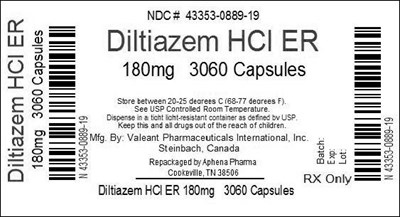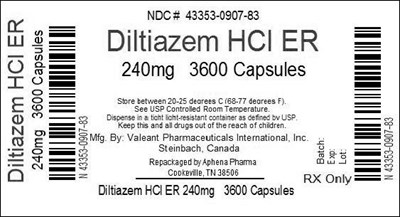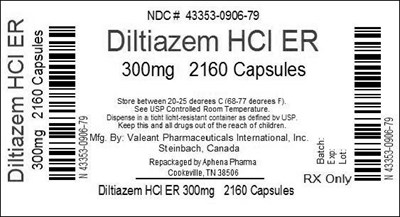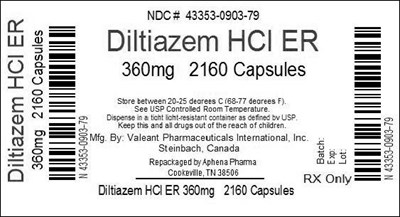FDA Label for Diltiazem Hydrochloride
View Indications, Usage & Precautions
- DESCRIPTION
- CLINICAL PHARMACOLOGY
- HYPERTENSION:
- CHRONIC STABLE ANGINA:
- CONTRAINDICATIONS
- ADVERSE REACTIONS
- OVERDOSAGE
- CONCOMITANT USE WITH OTHER CARDIOVASCULAR AGENTS.
- SPRINKLING THE CAPSULE CONTENTS ON FOOD
- HOW SUPPLIED
- REPACKAGING INFORMATION
- PRINCIPAL DISPLAY PANEL - 120MG
- PRINCIPAL DISPLAY PANEL - 180MG
- PRINCIPAL DISPLAY PANEL - 240MG
- PRINCIPAL DISPLAY PANEL - 300MG
- PRINCIPAL DISPLAY PANEL - 360MG
Diltiazem Hydrochloride Product Label
The following document was submitted to the FDA by the labeler of this product Aphena Pharma Solutions - Tennessee, Llc. The document includes published materials associated whith this product with the essential scientific information about this product as well as other prescribing information. Product labels may durg indications and usage, generic names, contraindications, active ingredients, strength dosage, routes of administration, appearance, warnings, inactive ingredients, etc.
Description
Diltiazem hydrochloride) is a calcium ion cellular influx inhibitor (slow channel blocker). Chemically, diltiazem hydrochloride is 1,5-Benzothiazepin-4(5H)-one,3-(acetyloxy)-5[2-(dimethylamino)ethyl]-2,-3-dihydro-2(4-methoxyphenyl)-, mono-hydrochloride, (+)-cis. The chemical structure is:
Diltiazem hydrochloride is a white to off-white crystalline powder with a bitter taste. It is soluble in water, methanol and chloroform and has a molecular weight of 450.98. Diltiazem hydrochloride extended-release capsules contain diltiazem hydrochloride in extended release beads at doses of 120, 180, 240, 300, 360 and 420 mg.
Diltiazem Hydrochloride extended-release capsules also contain: Microcrystalline Cellulose NF, Sucrose Stearate, Eudragit, Povidone USP, Talc USP, Magnesium Stearate NF, Hypromellose USP, Titanium Dioxide USP, Polysorbate NF, Simethicone USP, Gelatin NF, FD&C Blue #1, FD&C Red #40, D&C Red #28, FD&C Green #3, Black Iron Oxide USP, and other solids.
For oral administration.
Clinical Pharmacology
The therapeutic effects of diltiazem hydrochloride are believed to be related to its ability to inhibit the cellular influx of calcium ions during membrane depolarization of cardiac and vascular smooth muscle.
Hypertension:
Diltiazem hydrochloride extended-release capsules is indicated for the treatment of hypertension. It may be used alone or in combination with other antihypertensive medications.
Chronic Stable Angina:
Diltiazem hydrochloride extended-release capsules is indicated for the treatment of chronic stable angina.
Contraindications
Diltiazem is contraindicated in (1) patients with sick sinus syndrome except in the presence of a functioning ventricular pacemaker, (2) patients with second- or third-degree AV block except in the presence of a functioning ventricular pacemaker, (3) patients with severe hypotension (less than 90 mm Hg systolic), (4) patients who have demonstrated hypersensitivity to the drug, and (5) patients with acute myocardial infarction and pulmonary congestion documented by x-ray on admission.
Adverse Reactions
Serious adverse reactions have been rare in studies with diltiazem hydrochloride extended-release capsules as well as with other diltiazem formulations. It should be recognized that patients with impaired ventricular function and cardiac conduction abnormalities have usually been excluded from these studies. A total of 256 hypertensives were treated for between 4 and 8 weeks; a total of 207 patients with chronic stable angina were treated for 3 weeks with doses of diltiazem hydrochloride extended-release capsules ranging from 120-540 mg once daily. Two patients experienced first-degree AV block at the 540 mg dose. The following table presents the most common adverse reactions, whether or not drug-related, reported in placebo-controlled trials in patients receiving diltiazem hydrochloride extended-release capsules up to 360 mg and up to 540 mg with rates in placebo patients shown for comparison.
| Placebo | Diltiazem hydrochloride extended-release capsules | ||
|---|---|---|---|
| Adverse Events (COSTART Term) | n=57 # pts (%) | Up to 360 mg n=149 # pts (%) | 480-540mg n=48 # pts (%) |
| edema, peripheral | 1 (2) | 8 (5) | 7 (15) |
| dizziness | 4 (7) | 6 (4) | 2 (4) |
| vasodilation | 1 (2) | 5 (3) | 1 (2) |
| dyspepsia | 0 (0) | 7 (5) | 0 (0) |
| pharyngitis | 2 (4) | 3 (2) | 3 (6) |
| rash | 0 (0) | 3 (2) | 0 (0) |
| infection | 2 (4) | 2 (1) | 3 (6) |
| diarrhea | 0 (0) | 2 (1) | 1 (2) |
| palpitations | 0 (0) | 2 (1) | 1 (2) |
| nervousness | 0 (0) | 3 (2) | 0 (0) |
| Placebo | Diltiazem hydrochloride extended-release capsules | ||
|---|---|---|---|
| Adverse Events (COSTART Term) | n=50 # pts (%) | Up to 360 mg n=158 # pts (%) | 540 mg n=49 # pts (%) |
| headache | 1 (2) | 13 (8) | 4 (8) |
| edema, peripheral | 1 (2) | 3 (2) | 5 (10) |
| pain | 1 (2) | 10 (6) | 3 (6) |
| dizziness | 0 (0) | 5 (3) | 5 (10) |
| asthenia | 0 (0) | 1 (1) | 2 (4) |
| dyspepsia | 0 (0) | 2 (1) | 3 (6) |
| dyspnea | 0 (0) | 1 (1) | 3 (6) |
| bronchitis | 0 (0) | 1 (1) | 2 (4) |
| AV block | 0 (0) | 0 (0) | 2 (4) |
| infection | 0 (0) | 2 (1) | 1 (2) |
| flu syndrome | 0 (0) | 0 (0) | 1 (2) |
| cough increase | 0 (0) | 2 (1) | 1 (2) |
| extrasystoles | 0 (0) | 0 (0) | 1 (2) |
| gout | 0 (0) | 2 (1) | 1 (2) |
| myalgia | 0 (0) | 0 (0) | 1 (2) |
| impotence | 0 (0) | 0 (0) | 1 (2) |
| conjunctivitis | 0 (0) | 0 (0) | 1 (2) |
| rash | 0 (0) | 2 (1) | 1 (2) |
| abdominal enlargement | 0 (0) | 0 (0) | 1 (2) |
In addition, the following events have been reported infrequently (less than 2%) in clinical trials with other diltiazem products:
Cardiovascular. Angina, arrhythmia, AV block (second- or third-degree), bundle branch block, congestive heart failure, ECG abnormalities, hypotension, palpitations, syncope, tachycardia, ventricular extrasystoles.
Nervous System. Abnormal dreams, amnesia, depression, gait abnormality, hallucinations, insomnia, nervousness, paresthesia, personality change, somnolence, tinnitus, tremor.
Gastrointestinal. Anorexia, constipation, diarrhea, dry mouth, dysgeusia, mild elevations of SGOT, SGPT, LDH, and alkaline phosphatase (see hepatic warnings), nausea, thirst, vomiting, weight increase.
Dermatological. Petechiae, photosensitivity, pruritus.
Other. Albuminuria, allergic reaction, amblyopia, asthenia, CPK increase, crystalluria, dyspnea, edema, epistaxis, eye irritation, headache, hyperglycemia, hyperuricemia, impotence, muscle cramps, nasal congestion, neck rigidity, nocturia, osteoarticular pain, pain, polyuria, rhinitis, sexual difficulties, gynecomastia.
In addition, the following postmarketing events have been reported infrequently in patients receiving diltiazem hydrochloride: alopecia, erythema multiforme, exfoliative dermatitis, Stevens-Johnson syndrome, toxic epidermal necrolysis, extrapyramidal symptoms, gingival hyperplasia, hemolytic anemia, increased bleeding time, leukopenia, purpura, retinopathy, and thrombocytopenia. In addition, events such as myocardial infarction have been observed which are not readily distinguishable from the natural history of the disease in these patients. A number of well-documented cases of generalized rash, characterized as leukocytoclastic vasculitis, have been reported. However, a definitive cause and effect relationship between these events and diltiazem hydrochloride therapy is yet to be established.
Overdosage
The oral LD50's in mice and rats range from 415 to 740 mg/kg and from 560 to 810 mg/kg, respectively. The intravenous LD50's in these species were 60 and 38 mg/kg, respectively. The oral LD50 in dogs is considered to be in excess of 50 mg/kg, while lethality was seen in monkeys at 360 mg/kg.
The toxic dose in man is not known. Due to extensive metabolism, blood levels after a standard dose of diltiazem can vary over tenfold, limiting the usefulness of blood levels in overdose cases. There have been 29 reports of diltiazem overdose in doses ranging from less than 1 gm to 10.8 gm. Sixteen of these reports involved multiple drug ingestions. Twenty-two reports indicated patients had recovered from diltiazem overdose ranging from less than 1 gm to 10.8 gm. There were seven reports with a fatal outcome; although the amount of diltiazem ingested was unknown, multiple drug ingestions were confirmed in six of the seven reports.
Events observed following diltiazem overdose included bradycardia, hypotension, heart block, and cardiac failure. Most reports of overdose described some supportive medical measure and/or drug treatment. Bradycardia frequently responded favorably to atropine as did heart block, although cardiac pacing was also frequently utilized to treat heart block. Fluids and vasopressors were used to maintain blood pressure, and in cases of cardiac failure, inotropic agents were administered. In addition, some patients received treatment with ventilatory support, activated charcoal, and/or intravenous calcium. Evidence of the effectiveness of intravenous calcium administration to reverse the pharmacological effects of diltiazem overdose was conflicting.
In the event of overdose or exaggerated response, appropriate supportive measures should be employed in addition to gastrointestinal decontamination. Diltiazem does not appear to be removed by peritoneal or hemodialysis. Based on the known pharmacological effects of diltiazem and/or reported clinical experiences, the following measures may be considered:
Bradycardia: Administer atropine (0.60 to 1.0 mg). If there is no response to vagal blockage, administer isoproterenol cautiously.
High-Degree AV Block: Treat as for bradycardia above. Fixed high-degree AV block should be treated with cardiac pacing.
Cardiac Failure: Administer inotropic agents (isoproterenol, dopamine, or dobutamine) and diuretics.
Hypotension: Vasopressors (e.g. dopamine or levarterenol bitartrate). Actual treatment and dosage should depend on the severity of the clinical situation and the judgment and experience of the treating physician.
In a few reported cases, overdose with calcium channel blockers has been associated with hypotension and bradycardia, initially refractory to atropine but becoming more responsive to this treatment when the patients received large doses (close to 1 gram/hour for more than 24 hours) of calcium chloride.
Due to extensive metabolism, plasma concentrations after a standard dose of diltiazem can vary over tenfold, which significantly limits their value in evaluation cases of overdosage.
Charcoal hemoperfusion has been used successfully as an adjunct therapy to hasten drug elimination. Overdoses with as much as 10.8 gm of oral diltiazem have been successfully treated using appropriate supportive care.
Concomitant Use With Other Cardiovascular Agents.
1. Sublingual Nitroglycerin may be taken as required to abort acute anginal attacks during diltiazem hydrochloride therapy.
2. Prophylactic Nitrate Therapy - Diltiazem hydrochloride may be safely co-administered with short- and long-acting nitrates.
3. Beta-blockers. (See WARNINGS and PRECAUTIONS.)
4. Antihypertensives — Diltiazem hydrochloride has an additive antihypertensive effect when used with other antihypertensive agents. Therefore, the dosage of diltiazem hydrochloride or the concomitant antihypertensives may need to be adjusted when adding one to the other.
Hypertensive or anginal patients who are treated with other formulations of diltiazem can safely be switched to diltiazem hydrochloride extended-release capsules at the nearest equivalent total daily dose. Subsequent titration to higher or lower doses may, however, be necessary and should be initiated as clinically indicated.
Sprinkling The Capsule Contents On Food
Diltiazem hydrochloride extended-release capsules may also be administered by carefully opening the capsule and sprinkling the capsule contents on a spoonful of applesauce. The applesauce should be swallowed immediately without chewing and followed with a glass of cool water to ensure complete swallowing of the capsule contents. The applesauce should not be hot, and it should be soft enough to be swallowed without chewing. Any capsule contents/applesauce mixture should be used immediately and not stored for future use. Subdividing the contents of a diltiazem hydrochloride extended-release capsules is not recommended.
How Supplied
Repackaged by Aphena Pharma Solutions - TN. |
Diltiazem hydrochloride Extended-Release Capsules
| Strength | Description | Quantity | NDC# |
|---|---|---|---|
| 120 mg | #3 lavender/lavender capsule imprinted: 120 | 90's | 0258-3687-90 |
| 180 mg | #2 white/blue-green capsule imprinted: 180 | 90's | 0258-3688-90 |
| 240 mg | #1 blue-green/lavender capsule imprinted: 240 | 90's | 0258-3689-90 |
| 300 mg | #0 white/lavender capsule imprinted: 300 | 90's | 0258-3690-90 |
| 360 mg | #0 blue-green/blue-green capsule imprinted: 360 | 90's | 0258-3691-90 |
| 420 mg | #00 white/white capsule imprinted: 420 | 90's | 0258-3692-90 |
Repackaging Information
Please reference the How Supplied section listed above for a description of individual tablets or capsules. This drug product has been received by Aphena Pharma - TN in a manufacturer or distributor packaged configuration and repackaged in full compliance with all applicable cGMP regulations. The package configurations available from Aphena are listed below:
| Count | 120mg | 180mg | 240mg | 300mg | 360mg |
| 2160 | - | - | - | 43353-906-79 | 43353-903-79 |
| 3060 | - | 43353-889-19 | - | - | - |
| 3600 | - | - | 43353-907-83 | - | - |
| 6030 | 43353-888-17 | - | - | - | - |
Store between 20°-25°C (68°-77°F). See USP Controlled Room Temperature. Dispense in a tight light-resistant container as defined by USP. Keep this and all drugs out of the reach of children.
Repackaged by:
Cookeville, TN 38506
20140523SC
Principal Display Panel - 120Mg
NDC 43353-888 - Diltiazem HCI ER 120mg - Rx Only
Principal Display Panel - 180Mg
NDC 43353-889 - Diltiazem HCI ER 180mg - Rx Only
Principal Display Panel - 240Mg
NDC 43353-907 - Diltiazem HCI ER 240mg - Rx Only
Principal Display Panel - 300Mg
NDC 43353-906 - Diltiazem HCI ER 300mg - Rx Only
Principal Display Panel - 360Mg
NDC 43353-903 - Diltiazem HCI ER 360mg - Rx Only
* Please review the disclaimer below.






